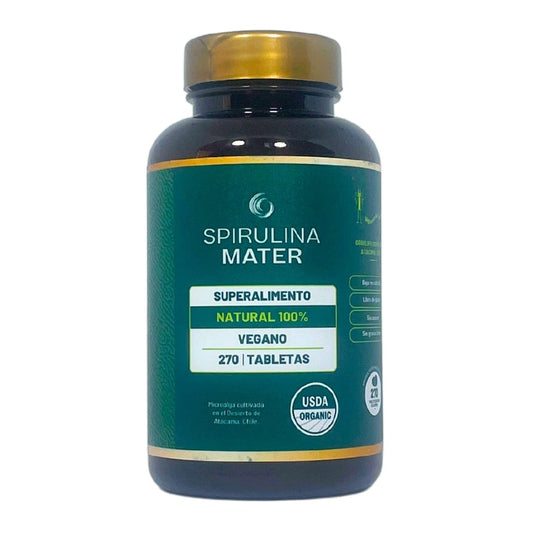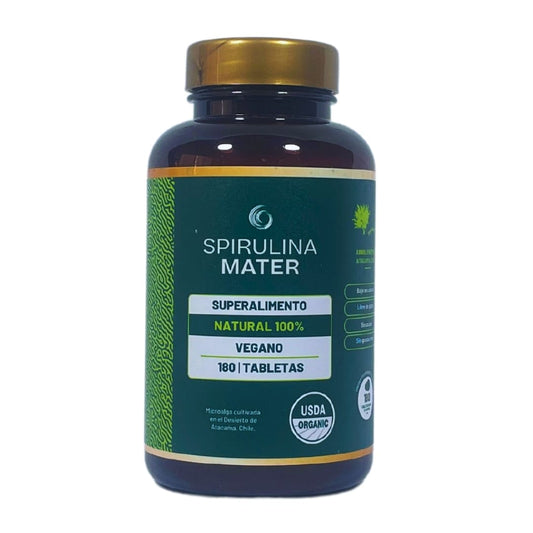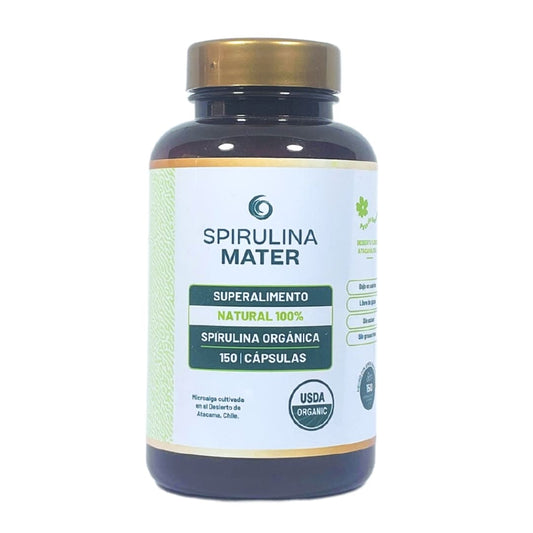How is Spirulina Mater produced?
Mainly we highlight that our crops are located in a privileged area in the heart of the Atacama Desert. Away from large towns. It should be noted that this is the driest and purest desert on the planet, Pampa del Tamarugal, first region, Iquique, Chile.

An analysis carried out by professionals in the area concluded that: the place where our Production Plant is located has very special characteristics:
1. The place where the plant is located is the second territory with the highest light intensity on the planet.
2. The dry climate that maintains purity. Low relative humidity.
3. It's not raining. Which keeps crops without deterioration.
4. High temperature.
5. Thermal sensation.
Our Spirulina Mater occurs in an oasis within the driest desert in the world: the Pampa del Tamarugal.
Other Factors
Another determining factor in the high quality of our Spirulina Mater is the good quality of the water with which it is grown. Despite being in the northern area, the waters of that site remain high quality and free of contaminants or heavy metals. Guaranteeing the quality and purity of the product.
The Spirulina maxima It is grown in large reactors similar to rectangular pools with a large surface area and shallow depth. These editors are optimal for Spirulina production and are filled with a specific growing medium. Which is prepared with water and selected mineral salts.
Another important aspect to take into account is that the minerals and nutrients are natural and fundamental for the alkaline culture medium in which Spirulina develops (ph between 9 and 10). The liquid inside the reactors is kept in permanent movement through a stirring system that allows uniformity of the culture throughout its volume.
Next, the dark green soup into which the crop is transformed (without any contact with the operators' hands) passes to a special harvest room through underground pipes. There it is separated from the culture medium, and the green cream that is obtained, after several processes, is reduced to a very fine dark green powder that is packaged and reaches you as SPIRULIN MATER.
On the other hand, it is important to point out that climatic conditions are decisive for establishing a Spirulina producing plant. As a result, latitudes must be chosen within the subtropical bands. And finally, the water for crops and plant processes must be drinkable, preferably from deep wells.
Plant region of Iquique – Pampa del Tamarugal. Spirulina Mater Production Plant.
The Spirulina Mater production plant is located in a natural ecosystem, resulting in a process attached to the hand of nature.
CULTIVATION AND HARVESTING YOUR Spirulina MATER
-
Maintenance of pure strains
This is a permanent task of maintaining the biological material that has been selected from the natural environment in which Spirulina proliferates. The most notable thing is that the biological material is maintained in isolation and controlled laboratory conditions; in no case is genetic manipulation of the microorganisms carried out. Only natural conditions are reproduced, optimizing the purity of the liquid environment in which they live (culture medium), consequently, better reproduction rates are achieved.

-
laboratory cultures
It is also a permanent work in which the selected biological material is reproduced. For this, controlled laboratory culture conditions are used, in terms of luminosity, temperature and air injection as a means to homogenize the cultures in small volumes (from 50 ml to 20 lt).

-
Inoculum production
It is a semi-continuous operation, growing Spirulina in ponds (culture reactors) covered under plastic or a greenhouse. In this stage, the material that arrives from the laboratory is reproduced and consists of two stages, whose volumes range from 250 liters to 60 m3.

-
Cultivation in production reactors
It is the intensive cultivation operation in large ponds or culture reactors in which the environmental conditions in which Spirulina naturally grows are reproduced. Optimizing productivity through a paddle wheel agitation system, which generates a crop flow similar to a river, allowing solar energy to be captured more efficiently.

-
Harvest
It is a unit operation in which Spirulina is separated from its aqueous culture medium, which is recycled back to the culture reactors. As a result of this operation, a pre-concentrate of Spirulina is obtained which is passed on to the next operation.

-
Washing and concentration
In this stage, two operations are carried out with the help of a vacuum filter. Firstly, the concentration of the biomass obtained in the harvesting operation is carried out and this biomass is immediately washed to remove salts from the culture medium that could be adsorbed on the Spirulina biomass.

-
Biomass homogenization
This unit operation consists exclusively of the conditioning of the biomass concentrated in the previous stage, to make its drying possible. The operation is carried out using a handmade machine that liquefies the paste and leaves it ready to move on to the next stage, in just 4 minutes of batch operation.

-
Drying
The liquefied biomass is spray-dried. It consists of making a shower of microparticles of the product to be dried come into contact with hot air, resulting in instantaneous evaporation, which allows obtaining a dry product in a matter of 2 to 3 seconds from the moment the contact with the hot air occurs. the drying chamber. The spray-drier is a machine of the same type as those used for powdered milk, egg powder, soluble coffee and other powdered foods that require drying at a high temperature for a very short time. In general, the product is pasteurized. in this operation.
REFERENCE PHOTO
 Conditioning and packaging
Conditioning and packaging -
It is an operation that has two phases. First is the reception of the product that comes out of the dryer (spray-drier). The second is to weigh the box with 25 kg and seal it and then store it in the corresponding warehouse. During this operation, samples are taken to send for analysis in an independent laboratory.

-
Tabletted and encapsulated
Next we have these two optional operations that are carried out to make the marketing and consumption of the product easier, and give it added value. Tableting is a traditional operation used in pharmacology just like encapsulation. In neither of the two operations are excipients or additives of any nature used.

-
Preparation of foods enriched with Spirulina
Finally, after making a careful analysis of the foods with which Spirulina combines from an organoleptic and nutritional point of view, the determined percentage of Spirulina powder is added in the final stage of the production of the chosen food.

Recommendations for selecting your spirulina
- First of all, the labeling must indicate the origin of the Spirulina. Spirulina Mater production comes from our farm which guarantees that it is of high quality and purity. Above all, it is a high quality NATIONAL PRODUCT.
- The aroma of Spirulina is sui generis, but it should never smell pestilential as happens with some others.
- Furthermore, the characteristic color of the powder or tablets is intense and uniform bluish-green. As a result, low-quality Spirulina is greenish-brown in color.
- On the other hand, the powder is very fine and soft in texture. Sometimes we have detected dust with textures and dots of other colors, therefore it indicates that the Spirulina has been reduced.
- Mix a pinch of Spirulina in a glass with water and let it rest. Spirulina breaks down into its three basic pigments: orange, green and blue. This is an indicator of quality and the high protein content of Spirulina.
- Finally, the packaging must be such that it does not allow the passage of light, air or other contaminants. Laminated bags are one of the best ways to keep the product in excellent condition for a long time.
You can watch our video about the production system here >>








